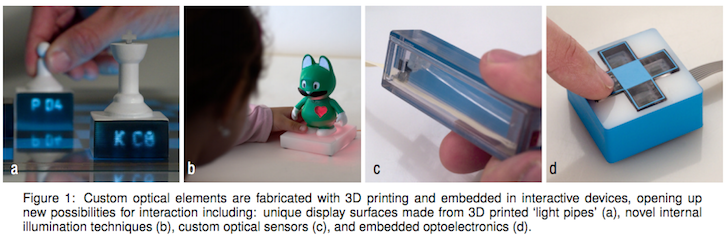When you think of companies that are doing 3D printing research, the name Disney doesn’t generally come to mind. But the company is serious about it, beyond merely the Carbon-Freeze Me and Disney Princess experiences at their amusement parks. Disney Research has a much bigger vision, a long term vision of creating interactive devices that are completely 3D printed. Obviously 3D-printed electronics is going to have to be a part of this goal, but there is a whole other area in which they are making strides that will be critical for interactivity. And that’s optics. 3D printed optics.
This Printed Optics technology, as they call it, will “enable sensing, display, and illumination elements to be directly embedded in the body of an interactive device. Using these elements, unique display surfaces, novel illumination techniques, custom optical sensors, and robust embedded components can be digitally fabricated for rapid, high fidelity, customized interactive devices.”
They’ve put out a white paper, Printed Optics: 3D Printing of Embedded Optical Elements for Interactive Devices, describing their vision and is available for your download and reading. The paper is produced by Karl D.D. Willis and Eric Brockmeyer of Disney Research in Pittsburgh, and by Scott E. Hudson and Ivan Poupyrev of the Computational Design Lab, HCI Institute, Carnegie Mellon University.
The paper is tremendous and you don’t need to be an engineer to read it. Here’s some of the elements of their vision they discuss–I hope it encourages you to take a look at it.
Light Pipes
Light pipes are similar to optical fiber, in that they guide light from point to point. Except these ones are 3D printed into any shape or geometry.
Internal Illumination
With the ability to print in a clear material, internal areas can be illuminated, interactively, in simple displays or complex volumetric displays.
Sensing Mechanical Movements
3D printed optical sensors in an interactive object can sense the mechanical movement of users, with such inputs as rotation, push, linear movement, and acceleration.
Watch this great video that shows you some of the things discussed in the white paper.
Source: Disney Research

